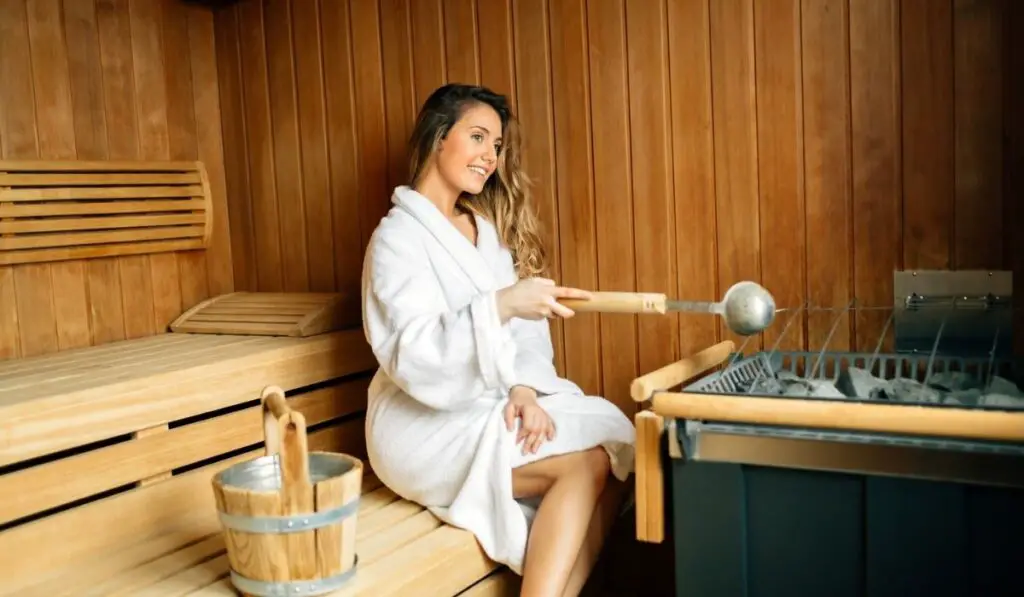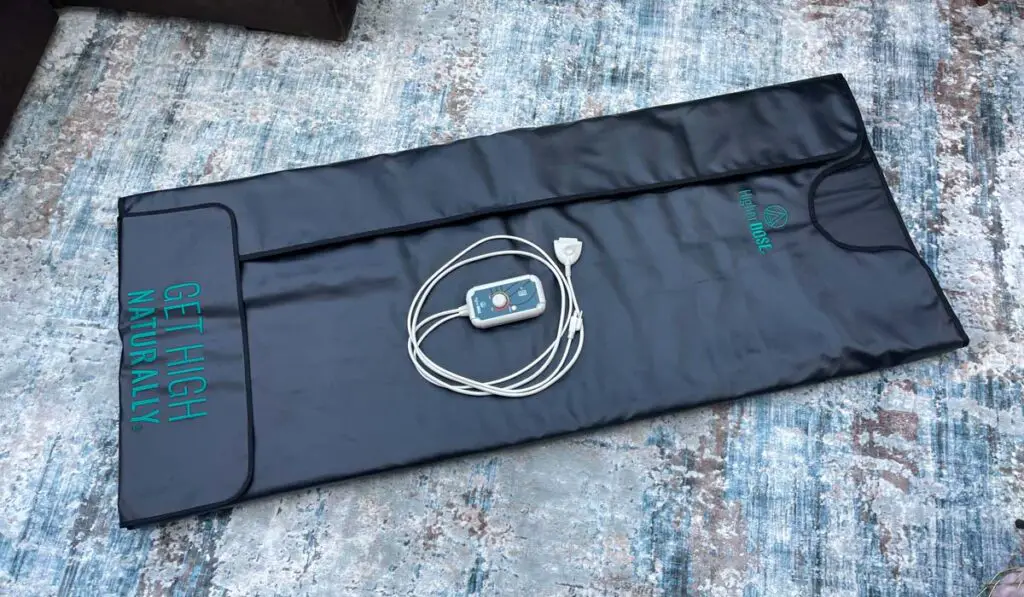Using the sauna correctly allows you to get all the amazing benefits, as well as staying safe. So you need to know the do’s and don’ts to get the most out of your sauna use, but what is it exactly that you should avoid and do instead?
When using a sauna, make sure you’re not staying in for too long of a period of time or wearing improper (tight) clothing. Don’t bring in your cell phone or other distractions. Stay in until you get a full-body sweat going, and then another 10-20 minutes. Wear loose, absorbent clothing, or just a towel, and stay hydrated.
There’s a lot to know about what to do and what not to do when you’re using a sauna. But before you start panicking- don’t worry, we’ve got you covered. By the time you’re done reading this, you’ll know all the ins and outs of using a sauna to get the best results.
Understanding the Purpose of Sauna Treatment

Saunas heal and revitalize the body and mind using heat. As your body temperature rises, internal reactions take place. Your heart rate and blood circulation increase, your immune system produces feel-good hormones like endorphins and serotonin, while producing fewer stress hormones like cortisol. Your immune system may also produce more illness-fighting white blood cells, and your pores open to release toxins as you sweat from the heat. This process has an abundance of health benefits.
Sauna use, while mentally relaxing, is a pretty strenuous workout for your internal body systems. To help your body react to sauna use in the best possible way, and to get the most out of your experience, there are things you should do in a sauna and things you should not do during your sauna experience. Let’s discuss them.
Things to Avoid Doing in the Sauna
Sometimes, people do things in the sauna that detract from the experience and interfere with all the health benefits. Using the sauna correctly for maximum enjoyment and benefits means avoiding certain behaviors.
Don’t Stay in for too Short a Time
How long you stay sat in the sauna matters. Stay in too long, and you risk overheating and becoming ill. Leave too early, though, and you’ll lose a lot of the health benefits.
You should aim for at least 15-20 minutes (if you’re new to the sauna life, though, start with shorter sessions of less than 10 minutes and gradually add a few more minutes with each subsequent session). Avoid staying in longer than 30 minutes, without leaving to cool off before re-entering.
your heart needs a chance to increase its own beats per minute and pump more blood through your body and open the pores of your skin. Additionally, your body needs a chance to start and maintain the sweating process. Once your blood is circulating and you’re sweating, the healing work like pain relief, health boosts for your lungs, brain, and other organs, and toxin removal can all take place.
Do listen to your body more so than the clock, however. If you begin to feel dizzy, nauseated, or your sweat diminishes, it’s time to leave and cool off a little.
Don’t Wear Tight Fitting Clothes or Apply Moisturizers Before
Wearing tight clothing is usually uncomfortable and restrictive in any hot area. Not only will wearing it in a sauna be distracting and make it hard to relax, but it will also interfere with your body’s ability to sweat. Perspiration needs to flow freely in order to flush out toxins.
For helpful insights on what to wear in a sauna, check out our article What You Should and Shouldn’t Wear in a Sauna.
Never apply moisturizers, lotions, perfumes, etc. before your sauna session. These substances can block pores and stop you from sweating freely. In fact, it’s best to shower before entering the sauna to make sure your skin is clean and free of any chemicals or lotions. Rinse yourself well after you shower, and you’ll be ready to get sweaty.
Don’t Bring in Distractions
Phones, watches, music, work, and even light reading are distractions that prevent you from fully relaxing and de-stressing. Many sauna goers and mental health experts argue that one of the most beneficial aspects of the entire sauna experience is the quiet, non-stimulating environment.
For the biggest boost to your well-being, enjoy your experience mindfully. This means leaving all distractions behind and giving your session your full, undivided attention. Focus on breathing deeply, feeling the tension leave your body, and enjoying the heat. To learn more, check out our full article on how best to pass the time in a sauna.
How to Use a Sauna Correctly
A sauna is any room or device that uses heat to stimulate healing responses in your body. While many people think of the classic wood-burning (or electric stove) sauna or infrared sauna rooms, there are many other types of saunas that do the same thing. Here’s how to use the most common types of saunas.
Note: if you are using any type of public sauna or steam room, such as one at your gym or health club, it’s important to follow proper etiquette to ensure that everyone has a pleasant, safe, and relaxing experience.
Some sauna rules of thumb:
- Enter and exit quickly rather than lingering in the doorway with the door hanging open. You don’t want to cause an annoying temperature drop by letting the cooler outside air in.
- Avoid being loud or otherwise disruptive. The sauna isn’t the place for conversations or music.
- Copy the crowd. Notice how people are dressed. If everyone is covered in a towel or swim suit, don’t be that person who sprawls out buck-naked on the bench.
- Remain seated rather than lying down, especially if the sauna is crowded.
- Be respectful in general, and don’t do anything that would annoy you if someone else did it.
Using a Traditional Fired Sauna Correctly
Whether they’re heated with electricity or fire, traditional saunas use a stove to heat the room to a set temperature. You want the temperature to be at least 150 degrees Fahrenheit (65 degrees Celsius) and no hotter than 175 degrees F (79 degrees C).
If you’d like to use it for longer than the recommended 15-20 minutes, it’s important to take regular breaks to allow your body time to cool off. Without this opportunity, your body’s cooling response becomes overwhelmed and shuts down, putting you at risk for heat exhaustion, heatstroke, or severe dehydration.
After about 15 minutes inside, step out and take a cool (or cold) shower or a plunge into a cool lake or river (in countries like Finland, sauna users often roll in the snow to cool down). Don’t forget to drink water, too. After 10 minutes, you can re-enter for another 15-minute session.
Wear a loose towel or bathing suit to allow yourself to sweat properly. Alternatively, you can be naked. If you choose to shed all clothing, though, be sure to cover the bench with a towel or a mat to protect your skin from burns and keep things sanitary.
Using an Infrared Sauna Correctly

An infrared sauna heats your body directly, so the room doesn’t get as hot as a traditional heated sauna. It does still get hot, though, with proper temperatures ranging from 120-130 degrees Fahrenheit (about 48-54 degrees Celsius). Operating your sauna outside of that range reduces the benefits and can be dangerous.
You can safely stay inside an infrared sauna for up to 45 minutes. While it’s okay to break up a long session by stepping outside to cool off, it isn’t a must like it is with a traditionally heated sauna. As with any sauna experience, let your body be your guide. If you feel lightheaded or nauseated, even after a short time, exit and drink water, eat a light snack, and rest.
Clothing guidelines are the same for infrared saunas as they are for traditional saunas. Loose-fitting clothing, a bathing suit, or a towel placed around you or on the bench is the typical attire. The benches won’t become as hot as they do in a stove-heated sauna so they’re not as likely to burn your skin, but most people consider them uncomfortably hot for bare skin.
Using a Steam Room Correctly
While the temperature in a steam room stays much cooler than in a sauna and tops off around 110 degrees Fahrenheit (43 degrees Celsius), steam rooms (sometimes called Turkish baths) can actually feel much hotter than saunas.
That’s because they use high humidity, reaching 100 percent, to activate your body’s cooling response. For safety, never let a steam room heat reach above that 110 degree mark.
Steam rooms may be cooler than traditional and infrared saunas, but you can still become overheated and dehydrated in them because your body’s internal temperature rises just like it does in other saunas. Therefore, 15-20 minutes is the optimum length of time with steam saunas, too, allowing you to stay in long enough for your body to respond but not so long that it is overworked and exhausted.
It’s very important to wear sandals, flip flops, or other appropriate footwear in a steam room. That’s because the wet environment is a breeding ground for bacteria and fungi, and with bare feet you can easily become infected with athlete’s foot or other skin conditions. This is true for the benches as well. It’s best to wear loose-fitting clothing, a swimsuit, or a towel, but if you really want to lounge in the nude, do so on a towel or mat.
Using a Sauna Blanket Correctly

Sauna blankets like the SurmountWay Sauna Blanket (on Amazon) are like leveled-up sleeping bags. They act like normal saunas but are more personal and cozy than a conventional sauna room. They use infrared heat to warm your body, and their temperature ranges from 80-160 degrees Fahrenheit (26-71 degrees Celsius).
Even though their temperature is cooler than other types of saunas, they heat your body just as efficiently to produce the same effects. You’ll be sweating even at 80 degrees Fahrenheit, so avoid the temptation to crank it up. Exceeding 160 degrees Fahrenheit can be dangerous, leading to overheating and severe dehydration as with other saunas.
When you’re first starting out with a sauna blanket, it’s safest to limit your sessions to 15 or 20 minutes. As your body becomes accustomed to the experience, you can gradually extend your time to enjoy it for 45 minutes or even an hour.
For sanitary purposes, it’s recommended that you wear clothing while inside your sauna blanket. You’ll be sweating as much as you would in any other sauna, though, so it’s very important to wear comfortable, loose-fitting, cotton clothing. You don’t want the toxin-containing sweat to cling to you. If you really prefer to go sans-clothes, be sure to thoroughly clean and dry your sauna blanket after every use.
Position your sauna blanket where it is most comfortable for you. It’s ideal to lie on a flat, firm surface, but it doesn’t have to be a hard, unyielding floor. You can place it on a bed or couch (remove the cushions if you’re looking for an even, firm surface). You can even use your sauna blanket while sitting in a chair. The key is to be comfortable so you can relax and let go of any stress and tension.
General Guidelines for Using Sauna Correctly
A sauna is a sauna regardless of the type. All heat-treat your body and make you sweat. No matter what sauna you choose, follow these guidelines for your health, safety, and enjoyment.
Hydrate, Hydrate, Hydrate
You’ll sweat about a pint of fluid when you’re in any sauna, so it’s important to drink at least six cups of water throughout your full experience. Begin sipping before you enter, continue while inside, and keep drinking water after you leave.
Avoid Alcohol and Recreational Drugs
Heating up and sweating intensify the effects of substances on your system, with serious (and sometimes even fatal) health consequences. Especially in the case of alcohol, which acts to dehydrate you, going into a sauna in this state will make you more likely to overheat.
You’ll be sweating a lot, which will detoxify you and help the body purge some of the toxins from that alcohol, but only if you’re hydrated enough to sweat in a normal way.
Use the Sauna Regularly
For the greatest benefits, use the sauna at least twice a week. Make it part of your weekly routine, using it on the same days and around the same time, to help form a habit.
Try Using it in the Late Afternoon or Evening
Using it later in the day can maximize the sleep benefits saunas provide. Your gradual drop in body temperature and levels of endorphins after your experience mimics what happens as your body prepares for sleep. To give yourself enough time for this to happen, avoid using the sauna right before bed.
Eat a Light, Healthy Snack Before and After Session
Doing so provides your body with necessary energy and prevents lightheadedness and weakness. Don’t eat anything heavy, though, as it will cause abdominal discomfort because of changes in blood flow.
We have a full article looking at the topic of when you should eat relative to your sauna session, and if you’re really looking to optimize things then you should make sure you eat after your session, not before.
Keep your Sauna Clean
Avoid build-up of illness-causing bacteria and fungi by cleaning your sauna regularly. A sauna can harbor bacteria and mold because of it’s warm and humid environment, but if it is cleaned correctly, then there’s no need to worry about these issues.
To Wrap-up
All saunas provide benefits, so choose the type that’s right for you. And whatever type you use, follow these do’s and don’ts for the most enjoyable experience. Now that you know what you should and should not do in a sauna, it’s time to enjoy, relax, and reap the benefits.
